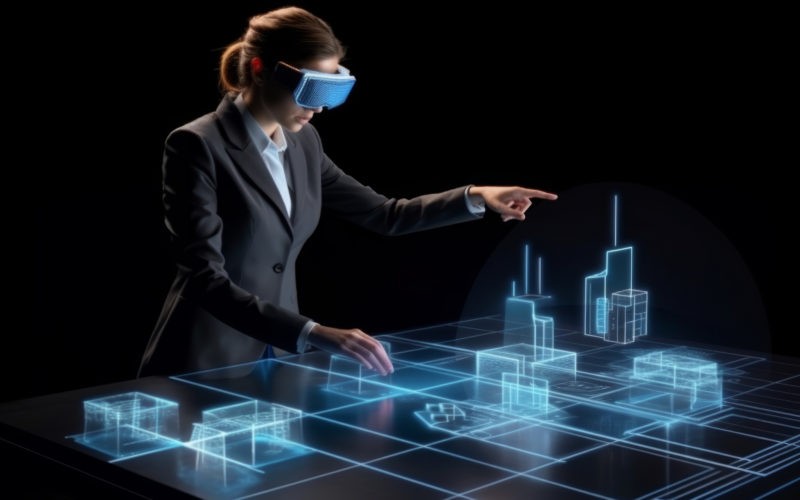In recent years, the metaverse concept has captured the imagination of tech enthusiasts, investors, and futurists alike. As we stand on the brink of a new digital era, innovative metaverse projects are emerging as the architects of our future virtual spaces. These projects are not just reimagining how we interact online; they’re reshaping the very fabric of our digital existence. In this comprehensive exploration, we’ll dive deep into the world of metaverse projects, examining their potential to transform various aspects of our lives and the technologies driving this revolution.
What Are Metaverse Projects?
Before we delve into specific innovations, it’s crucial to understand what metaverse projects entail. At their core, metaverse projects are initiatives to create or enhance immersive, persistent virtual worlds where users can interact, create, and transact in ways that blur the lines between physical and digital realities.
These projects typically encompass several key elements:
- 3D Virtual Environments: Immersive digital spaces that users can explore and interact with.
- Avatar Systems: Customizable digital representations of users.
- Social Interaction Tools: Features that enable communication and collaboration between users.
- Economic Systems: Virtual economies, often powered by cryptocurrencies or tokens.
- Content Creation Platforms: Tools that allow users to create and share virtual assets or experiences.
- Interoperability Solutions: Technologies that enable seamless movement between different virtual spaces.
Metaverse projects can range from comprehensive virtual world platforms to specialized applications focusing on specific aspects of the metaverse experience.
The Rise of Metaverse Crypto Projects
One of the most exciting developments in the metaverse space is the integration of blockchain technology and cryptocurrencies. Metaverse crypto projects are at the forefront of this convergence, leveraging blockchain to create decentralized virtual economies and enable true digital ownership.
Key features of metaverse crypto projects include:
- Tokenization of Virtual Assets: Using blockchain to create unique, verifiable digital items (NFTs).
- Decentralized Governance: Allowing users to have a say in the development and management of virtual worlds.
- Play-to-Earn Models: Enabling users to earn cryptocurrency by participating in virtual activities.
- Cross-Platform Asset Portability: Facilitating the transfer of digital assets between different metaverse platforms.
These projects are not only reshaping how we think about virtual economies but also democratizing the creation and ownership of digital content.
Top Metaverse Projects Pushing Boundaries
While we won’t mention specific names, it’s worth exploring some categories of top metaverse projects that are currently shaping the landscape:
- Virtual World Platforms: Comprehensive metaverse environments where users can socialize, play, and create.
- Blockchain-Based Virtual Lands: Projects that tokenize virtual real estate, allowing users to buy, sell, and develop digital property.
- VR Social Platforms: Immersive social networks designed for virtual reality experiences.
- Augmented Reality Overlays: Projects that blend digital elements with the physical world through AR technology.
- Metaverse Gaming Ecosystems: Game worlds that incorporate metaverse elements like persistent economies and user-generated content.
- Virtual Fashion and Avatar Customization: Platforms focused on digital fashion and identity expression.
- Decentralized Metaverse Infrastructures: Projects building the foundational technologies for interoperable, decentralized virtual worlds.
Each of these categories represents a unique approach to realizing the metaverse vision, with projects often overlapping and combining elements from multiple categories.
Innovative Features Driving Metaverse Projects
The most groundbreaking metaverse projects are distinguished by their innovative features. Here are some cutting-edge elements that are pushing the boundaries of what’s possible in virtual spaces:
- AI-Powered NPCs: Non-player characters driven by advanced AI, creating more realistic and dynamic virtual worlds.
- Haptic Feedback Integration: Technologies that allow users to “feel” virtual objects, enhancing immersion.
- Brain-Computer Interfaces: Experimental projects exploring direct neural connections to virtual environments.
- Photorealistic Avatars: Advanced 3D modeling and animation techniques to create lifelike digital representations.
- Dynamic World-Building: AI-assisted tools that can generate and modify virtual environments in real time.
- Cross-Reality Experiences: Seamless transitions between VR, AR, and physical reality.
- Decentralized Identity Systems: Blockchain-based solutions for portable digital identities across the metaverse.
- Virtual-to-Physical Interactions: Systems that allow actions in the metaverse to trigger effects in the physical world (and vice versa).
These features represent the cutting edge of metaverse technology, with the potential to revolutionize how we experience and interact with virtual spaces.
The Impact of Metaverse Projects on Various Sectors
Innovative metaverse projects are not confined to the realm of entertainment; they’re poised to transform numerous industries:
- Education: Virtual classrooms and immersive learning experiences.
- Healthcare: Remote medical consultations and virtual therapy sessions.
- Real Estate: Virtual property development and digital twin technologies.
- Retail: Immersive shopping experiences and virtual try-ons.
- Workplace Collaboration: Virtual offices and enhanced remote work tools.
- Tourism: Virtual travel experiences and augmented tourist attractions.
- Art and Culture: Digital museums, virtual concerts, and new forms of creative expression.
- Finance: Decentralized finance (DeFi) integration and virtual banking services.
As metaverse projects continue to evolve, their influence on these and other sectors is likely to grow, creating new opportunities and challenges.
Challenges Facing Metaverse Projects
Despite the exciting potential, metaverse projects face several significant challenges:
- Technological Limitations: Current hardware may not be capable of delivering fully immersive experiences at scale.
- Interoperability Issues: Lack of standardization makes it difficult for different metaverse platforms to interact seamlessly.
- Privacy and Security Concerns: The immersive nature of the metaverse raises new questions about data protection and user safety.
- Regulatory Uncertainty: The legal framework for governing virtual worlds and digital assets is still evolving.
- Digital Divide: Unequal access to technology could create new forms of social and economic inequality.
- Content Moderation: Managing user behavior and content in vast, real-time virtual environments is a complex challenge.
- Environmental Impact: The energy consumption of metaverse infrastructure raises sustainability concerns.
Addressing these challenges will be crucial for the long-term success and widespread adoption of metaverse projects.
The Future of Metaverse Projects
As technology continues to advance, we can expect metaverse projects to evolve in several key ways:
- Increased Realism: Improvements in graphics, physics simulations, and sensory feedback will create more lifelike virtual experiences.
- Greater Accessibility: Advancements in cloud computing and 5G networks will make metaverse experiences more widely available.
- Enhanced AI Integration: AI will play a larger role in creating dynamic, responsive virtual environments.
- Blockchain Evolution: New blockchain solutions will emerge to address scalability and energy efficiency concerns.
- Metaverse-Physical World Integration: The line between virtual and physical realities will continue to blur, with more seamless integration between the two.
- New Forms of Governance: Novel systems for managing and governing virtual worlds will emerge, potentially influencing real-world governance models.
- Metaverse-Native Innovations: We’ll see the rise of new industries and job roles that exist primarily or entirely within virtual spaces.
These developments promise to expand the capabilities and applications of metaverse projects, potentially reshaping numerous aspects of our digital and physical lives.
Case Studies: Groundbreaking Metaverse Projects
While avoiding specific names, let’s examine some anonymous case studies of innovative metaverse projects:
- A decentralized virtual world platform where users can buy, sell, and develop parcels of digital land, with all transactions recorded on a blockchain.
- A VR-based social network that uses advanced haptic technology to allow users to “feel” virtual interactions, revolutionizing long-distance communication.
- An augmented reality project that overlays historical information and reconstructions onto real-world locations, transforming how we experience cultural heritage.
- A metaverse gaming ecosystem that allows players to earn cryptocurrency by completing quests and trading virtual items, creating new economic opportunities.
- A virtual fashion platform where designers can create and sell digital clothing as NFTs, wearable across multiple metaverse environments.
These examples showcase the diversity and potential of current metaverse projects, hinting at the transformative impact they could have on various aspects of our lives.
How to Evaluate Metaverse Projects
For those interested in exploring or investing in metaverse projects, here are some key factors to consider:
- Technology Stack: Assess the underlying technologies and their potential for scalability and innovation.
- User Experience: Evaluate the quality and accessibility of the virtual experience.
- Community and Ecosystem: Look at the size and engagement of the user community and the broader ecosystem of developers and creators.
- Tokenomics: For crypto-based projects, understand the economic model and token distribution.
- Interoperability: Consider how well the project integrates with other metaverse platforms and technologies.
- Team and Backers: Research the expertise of the development team and the credibility of investors.
- Roadmap and Vision: Examine the project’s long-term plans and how they align with broader metaverse trends.
By carefully considering these factors, individuals and businesses can make more informed decisions about which metaverse projects to engage with or support.
Conclusion: The Metaverse Frontier
Innovative metaverse projects are at the forefront of a digital revolution, pushing the boundaries of what’s possible in virtual spaces. From immersive social experiences to new economic models, these projects are laying the groundwork for a future where the lines between physical and digital realities are increasingly blurred.
As we’ve explored, the landscape of metaverse projects is diverse and rapidly evolving. From comprehensive virtual world platforms to specialized applications in education, healthcare, and beyond, these initiatives are reshaping how we interact, work, and play in digital spaces.
While challenges remain, particularly in areas like interoperability, privacy, and accessibility, the potential of metaverse projects to transform various aspects of our lives is immense. As technology continues to advance and more innovators enter the space, we can expect to see even more groundbreaking developments in the coming years.
For individuals, businesses, and society at large, understanding and engaging with metaverse projects is becoming increasingly important. Whether as users, creators, or investors, our participation in these virtual spaces will help shape the digital future we’re building.
As we stand on the brink of this new frontier, one thing is clear: the metaverse is not just a technological revolution, but a cultural and economic one as well. The innovative metaverse projects of today are laying the foundation for a future where our digital experiences are as rich, diverse, and impactful as our physical ones. The journey into this new digital realm has only just begun, and the possibilities are limitless.












